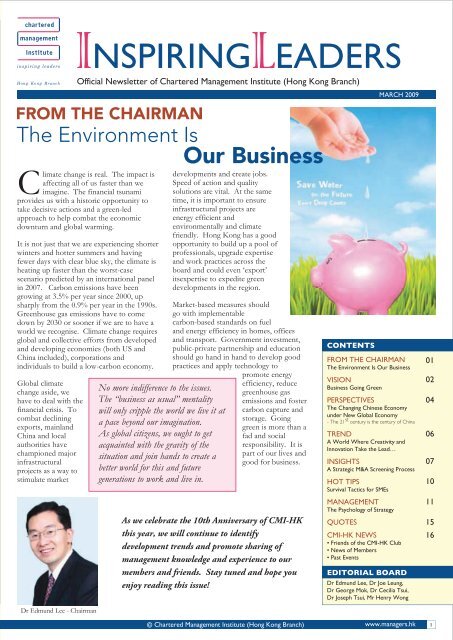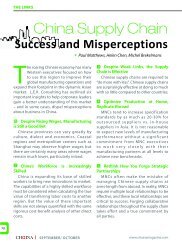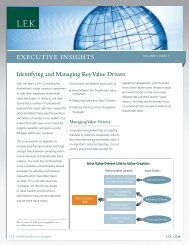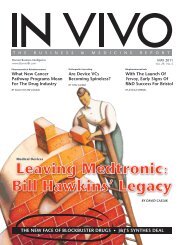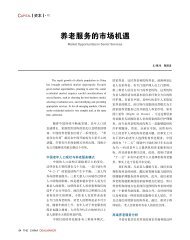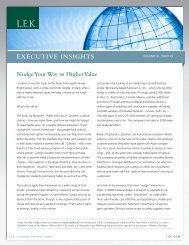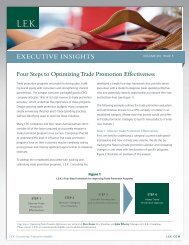A Strategic M&A Screening Process - LEK Consulting
A Strategic M&A Screening Process - LEK Consulting
A Strategic M&A Screening Process - LEK Consulting
Create successful ePaper yourself
Turn your PDF publications into a flip-book with our unique Google optimized e-Paper software.
INSPIRINGLEADERS<br />
Official Newsletter of Chartered Management Institute (Hong Kong Branch)<br />
FROM THE CHAIRMAN<br />
The Environment Is<br />
Our Business<br />
limate change is real. The impact is<br />
affecting all of us faster than we<br />
imagine. The financial tsunami<br />
provides us with a historic opportunity to<br />
take decisive actions and a green-led<br />
approach to help combat the economic<br />
downturn and global warming.<br />
It is not just that we are experiencing shorter<br />
winters and hotter summers and having<br />
fewer days with clear blue sky, the climate is<br />
heating up faster than the worst-case<br />
scenario predicted by an international panel<br />
in 2007. Carbon emissions have been<br />
growing at 3.5% per year since 2000, up<br />
sharply from the 0.9% per year in the 1990s.<br />
Greenhouse gas emissions have to come<br />
down by 2030 or sooner if we are to have a<br />
world we recognise. Climate change requires<br />
global and collective efforts from developed<br />
and developing economies (both US and<br />
China included), corporations and<br />
individuals to build a low-carbon economy.<br />
Global climate<br />
change aside, we<br />
have to deal with the<br />
financial crisis. To<br />
combat declining<br />
exports, mainland<br />
China and local<br />
authorities have<br />
championed major<br />
infrastructural<br />
projects as a way to<br />
stimulate market<br />
Dr Edmund Lee - Chairman<br />
developments and create jobs.<br />
Speed of action and quality<br />
solutions are vital. At the same<br />
time, it is important to ensure<br />
infrastructural projects are<br />
energy efficient and<br />
environmentally and climate<br />
friendly. Hong Kong has a good<br />
opportunity to build up a pool of<br />
professionals, upgrade expertise<br />
and work practices across the<br />
board and could even ‘export’<br />
itsexpertise to expedite green<br />
developments in the region.<br />
No more indifference to the issues.<br />
The “business as usual” mentality<br />
will only cripple the world we live it at<br />
a pace beyond our imagination.<br />
As global citizens, we ought to get<br />
acquainted with the gravity of the<br />
situation and join hands to create a<br />
better world for this and future<br />
generations to work and live in.<br />
Market-based measures should<br />
go with implementable<br />
carbon-based standards on fuel<br />
and energy efficiency in homes, offices<br />
and transport. Government investment,<br />
public-private partnership and education<br />
should go hand in hand to develop good<br />
practices and apply technology to<br />
promote energy<br />
efficiency, reduce<br />
greenhouse gas<br />
emissions and foster<br />
carbon capture and<br />
storage. Going<br />
green is more than a<br />
fad and social<br />
responsibility. It is<br />
part of our lives and<br />
good for business.<br />
As we celebrate the 10th Anniversary of CMI-HK<br />
this year, we will continue to identify<br />
development trends and promote sharing of<br />
management knowledge and experience to our<br />
members and friends. Stay tuned and hope you<br />
enjoy reading this issue!<br />
CONTENTS<br />
MARCH 2009<br />
MARCH 2009<br />
FROM THE CHAIRMAN<br />
The Environment Is Our Business<br />
VISION<br />
Business Going Green<br />
PERSPECTIVES<br />
The Changing Chinese Economy<br />
under New Global Economy<br />
- The 21 st century is the century of China<br />
TREND<br />
A World Where Creativity and<br />
Innovation Take the Lead…<br />
INSIGHTS<br />
A <strong>Strategic</strong> M&A <strong>Screening</strong> <strong>Process</strong><br />
HOT TIPS<br />
Survival Tactics for SMEs<br />
MANAGEMENT<br />
The Psychology of Strategy<br />
QUOTES<br />
CMI-HK NEWS<br />
• Friends of the CMI-HK Club<br />
• News of Members<br />
• Past Events<br />
EDITORIAL BOARD<br />
Dr Edmund Lee, Dr Joe Leung,<br />
Dr George Mok, Dr Cecilia Tsui,<br />
Dr Joseph Tsui, Mr Henry Wong<br />
© Chartered Management Institute (Hong Kong Branch) www.managers.hk<br />
01<br />
02<br />
04<br />
06<br />
07<br />
10<br />
11<br />
15<br />
16<br />
1
M<br />
ergers and acquisitions (M&A) is often a critical<br />
component of growth and diversification.<br />
As many valuable deals are overlooked and too<br />
many M&As have failed to live up to expectations,<br />
opportunity prevails for significant process improvement.<br />
Steven Rosner and Helen Chen of L.E.K. <strong>Consulting</strong><br />
share with us that by taking steps to implement a proactive<br />
and structured screening system, companies can contribute<br />
significantly to the success of their M&A strategy, save<br />
considerable time, effort and resources, achieve a positive<br />
bottom line results and increase shareholder value.<br />
INSIGHTS<br />
A <strong>Strategic</strong> M&A <strong>Screening</strong> <strong>Process</strong><br />
Applying a formal<br />
screening methodology involves<br />
developing clear inclusion/exclusion<br />
and prioritisation criteria, building a<br />
comprehensive candidate list, applying<br />
the criteria to narrow the scope of<br />
potential targets and producing<br />
in-depth candidate profiles to enable a<br />
more informed approach to the initial<br />
due diligence stage.<br />
M&A is often a critical component of growth and diversification. In consulting with a broad<br />
range of companies throughout the M&A process, many organisations do not have a<br />
systematic screening process in place to ensure that their M&A efforts support their<br />
corporate growth strategies.<br />
Potential deals are often initiated informally, via a telephone call or a personal conversation<br />
with an investment banker, a business broker, or a business development executive at another<br />
firm. This approach to identifying opportunities is at best described as “ad-hoc”, in which<br />
screening criteria are informal or undefined and are applied inconsistently to potential<br />
opportunities.<br />
Not surprisingly, this can result in sub-optimal outcomes. When sub-par opportunities are<br />
considered, management time may be wasted and unnecessary costs incurred. The “right”<br />
deal may go unexamined.<br />
On the other hand, a proactive, systematic approach to the M&A process, including a<br />
well-defined screening stage, creates substantially greater potential for success. A<br />
comprehensive screening process arms organisations with a structured methodology that<br />
enables fast, effective responses to sound opportunities. Whether for in-licensing products,<br />
acquiring companies, or seeking a merger partner, a proactive screening process is a crucial<br />
step in the M&A process.<br />
The overall M&A process has several major stages (Exhibit 1). Acquisition screening<br />
immediately follows the first stage of strategy development and sets the foundation for the<br />
rest of the process.<br />
Inspiring Leaders © Chartered Management Institute (Hong Kong Branch) March 09<br />
7
The Benefits of a Proactive M&A <strong>Screening</strong> <strong>Process</strong><br />
The <strong>Screening</strong> <strong>Process</strong><br />
8<br />
4.<br />
5.<br />
Establish<br />
<strong>Screening</strong><br />
Criteria<br />
Building<br />
Comprehensive<br />
List<br />
M&A<br />
Strategy<br />
Acquisition<br />
<strong>Screening</strong><br />
Prioritize<br />
Comprehensive<br />
List<br />
Target<br />
Investigation<br />
Develop<br />
Profiles<br />
Valuation<br />
Analysis<br />
Post-<br />
Acquisition<br />
Planning<br />
Post-<br />
Acquisition<br />
Integration<br />
A company can derive five key benefits from a proactive approachto the M&A process:<br />
1.<br />
2.<br />
3.<br />
Enhanced strategic consistency<br />
Companies that use a systematic and proactive screening process target their<br />
business development activities at opportunities that help fulfil their business<br />
strategy.<br />
Opportunity prioritisation<br />
A proactive approach enables a company to target the most attractive<br />
companies or products first, increasing the overall likelihood of deal success<br />
and minimising time and effort wasted on less optimal opportunities.<br />
Efficient use of limited resources<br />
The approach ensures resources are consistently focused on the highest priority<br />
opportunities and maximises the return on a company’s time and efforts.<br />
Reduced politics<br />
By adopting a structured approach to acquisition screening – one that is driven by strategic goals, a comprehensive list of<br />
opportunities and clear screening criteria – one can significantly reduce bias and political factors arisen from personal and<br />
professional relationships and individual preferences.<br />
A framework for ongoing analysis<br />
A formal screening process can assist companies in maintaining a clear paper trail of the decision making process, helping<br />
business leaders keep track of opportunities evaluated over time and enabling ongoing analysis in light of developments.<br />
Understanding the Components of an Effective M&A <strong>Screening</strong> Strategy<br />
There are four essential steps in the M&A acquisition screening process (Exhibit 2).<br />
Step 1 - Establish and Define <strong>Screening</strong> Criteria<br />
A well designed M&A strategy articulates the organisation’s goals and highlights the factors that make an opportunity<br />
attractive. This drives screening based on inclusion, exclusion, or prioritisation criteria. Inclusion and exclusion criteria are<br />
relatively straightforward. Generally, 50 to 80 percent of prospects can be excluded in the evaluation stage by employing<br />
inclusion or exclusion criteria. Some examples include:<br />
››<br />
››<br />
››<br />
››<br />
Geographic Criteria –<br />
“U.S. based headquarters with 90 percentor more of the sales in the U.S.”<br />
Product or Customer Criteria –<br />
“Pharmaceutical products to be prescribed by a cardiologist”<br />
Size Criteria –<br />
“Revenues greater than $20 million”<br />
Capabilities Criteria –<br />
“Companies with low cost manufacturing capabilities in China”<br />
Prioritisation criteria take into account other options.<br />
Some examples include:<br />
• Time or Date –<br />
“10 years of patent protection is better than 5,but how much better?”<br />
• Size –<br />
“$100 to $500 million in sales is best, but $50 million to $100 million is sufficient”<br />
• Product Position –<br />
“Brands or products in number two share position may also be attractive”<br />
Inspiring Leaders © Chartered Management Institute (Hong Kong Branch) www.managers.hk
Step 2 - Build a Comprehensive Candidate List<br />
The initial list should be assembled from multiple sources, such as SIC codes, industry databases, trade associations, mailing<br />
lists and industry journals. When multiple or conflicting opinions exist, a comprehensive list will facilitate consensus-building<br />
and result in more objective decisions.<br />
Step 3 - Prioritise Comprehensive List<br />
Inclusion and exclusion criteria can now be applied to the comprehensive list. Data may come from secondary sources and<br />
primary research. Some clients use a numerical rating system, which give scores to each criterion. Some may allocate<br />
weightings while others may perform the assessment on a qualitative basis.<br />
Step 4 - Develop Profiles<br />
Once the final list of potential targets has been refined, it is critical to develop a profile. Typical profiles may include the<br />
following:<br />
››<br />
››<br />
››<br />
››<br />
››<br />
››<br />
Key company information such as history, ownership structure, size, location(s) and<br />
organisational structure<br />
Background and contact information on key company<br />
decision makers<br />
Management team background<br />
Product and patent information<br />
Segment trends, customer and market data<br />
Current business alliances and competitive situation<br />
With these profiles in hand, decision-makers have enough<br />
information to make an initial approach to an M&A target.<br />
L.E.K. <strong>Consulting</strong> is a global strategy consulting<br />
firm. Steven Rosner is a Vice President in the<br />
firm’s Boston office and Helen Chen a Director in<br />
the firm’s Shanghai office.<br />
Steven Rosner Helen Chen<br />
L.E.K. Case Study: An IT Staffing Company Grows its Business with the Help of Proactive M&A <strong>Screening</strong><br />
First, a set of criteria was established for potential targets in terms of the size of the company in revenues,<br />
geographic location(s), capabilities and skill sets offered. Next, a broad target list was created using a variety of<br />
sources, such as member lists from industry trade organisations, to establish a universe of over 900 potential<br />
candidates.<br />
Using the inclusion/exclusion criteria, the list was pared down to 120 companies. The 120 companies were<br />
researched in greater depth to prioritise them into A, B or C tiers.<br />
Ultimately, additional information was gathered on the A tier companies – most of which were privately owned – to<br />
create more detailed profiles. In approaching these candidates, the client let each one know that their organisation<br />
had been carefully chosen from a field of nearly 1,000 candidates.<br />
By demonstrating in-depth knowledge of the target companies, the client made a favourable impression on the<br />
companies’ owners that left them more open to considering and accepting an offer. The client ultimately acquired<br />
several of these companies, adding a new and profitable line of business to its existing operations.<br />
Inspiring Leaders © Chartered Management Institute (Hong Kong Branch) March 09<br />
9


